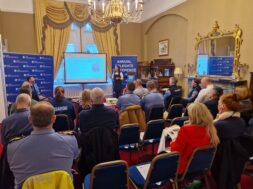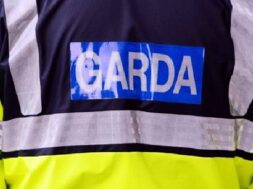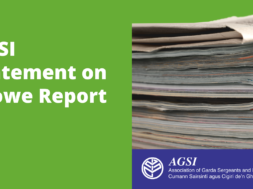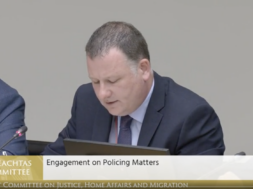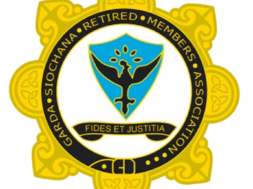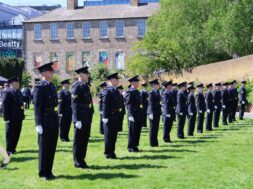Statement by Frances Fitzgerald TD, Minister for Justice & Equality on the
Cooke Report – Dáil Éireann – 19th June 2014
A Cheann Comhairle,
I welcome this opportunity for the House to debate the findings and
recommendations of the report by Judge Cooke into claims of unlawful
surveillance of the Garda Síochána Ombudsman Commission.
Judge Cooke’s authoritative report assesses, in a balanced and measured
way, the evidence for these claims.
As the House knows, the Sunday Times on 9th February 2014 claimed that the
offices of GSOC had been targeted in a sophisticated surveillance operation
which used Government-level technology to hack into its e-mail, Wi-Fi and
phone systems.
On 13th February 2014, after the publication of this article, GSOC
submitted a report to the then Minister on the matter. In their report,
which should have been submitted earlier as required by statute, GSOC
explained that they had brought in a specialist IT company to conduct a
security sweep of their premises in September 2013 which had initially
identified two operational surveillance threats, and that a third such
threat later.
Subsequently, on 8th October GSOC initiated an investigation into these
issues under section 102(4) of the Garda Síochána Act 2005. This provision
enables GSOC, if it appears to it desirable in the public interest, to
investigate any matter indicating to GSOC that a member of the Garda
Síochána may have committed an offence or behaved in a manner that would
justify disciplinary proceedings.
The report by GSOC to the then Minister explained that the conclusion of
the GSOC investigation under section 102(4) was that it – and I quote –
“did not find any definitive evidence that GSOC was under technical or
electronic surveillance. It did, however, uncover a number of technical
and electronic anomalies that cannot be explained”.
The House will recall that the Sunday Times claims led to a considerable
level of comment and debate, resulting in a statement by the then Minister
to this House, plus an appearance by GSOC Commissioners and the then
Minister before the Joint Oireachtas Committee on Public Service Oversight
and Petitions.
It is entirely understandable that these claims led to serious disquiet,
which in turn had the potential, and indeed effect, of undermining the
continued public confidence in policing and the oversight of policing.
That is why the Government decided that it was essential for these claims
of unlawful surveillance to be examined in an independent, impartial and
authoritative manner. It therefore appointed a former distinguished judge
of the High Court, Judge Cooke, to carry out an independent inquiry into
the claims, and this was approved by resolution of this House.
The terms of reference of the Inquiry were, in summary, to establish the
sequence of events and facts leading up to and relating to the
investigation by GSOC into the security concerns, to examine all reports,
documentation and other evidence relevant to that investigation, to review
and assess any evidence of a security breach or attempted security breach
at GSOC’s premises, and to make any recommendations relating to
improvements to GSOC’s security, to legislation or otherwise.
The key finding of Mr Justice Cooke is that it is – and I quote – “clear
that the evidence does not support the proposition that actual surveillance
of the kind asserted in the Sunday Times article took place and much less
that it was carried out by members of the Garda Síochána”.
The report by Mr Justice Cooke also analyses in detail the evidence in
relation to the three threats identified by the security sweep of GSOC’s
premises. Much has since been written and spoken about these threats, and
it is important to look at the findings of Judge Cooke in this regard.
Firstly, It was alleged that a handheld wireless device associated with AV
equipment, located in the area of the GSOC boardroom was connecting and
transferring (audio) data to an external ‘Bitbuzz’ hotspot. This device
became known as device 4B. It was further claimed that the device had been
reconfigured and it was suggested this was evidence of interference.
Judge Cooke finds as “not convincing” the accounts of device 4B
authenticating a connection to the external ‘Bitbuzz’ hotspot, as ‘Bitbuzz’
would have had a record of the MAC address of device 4B if the connection
had been made and authenticated.
Judge Cooke found it “highly improbable that the haphazard performance of
such a… device constituted the planned means of covert eavesdropping on
GSOC in a sophisticated surveillance exercise by any agency equipped with a
capability of ‘intelligence service level’”.
Judge Cooke goes on to add that “the possibly sinister characterisation
attributed to its abnormal behaviour appears now to warrant reconsideration
in view of the fact that: a) it was not microphone enabled as had been
assumed; and b) its original default password was publicly available and
had not been changed.” On this last point, Judge Cooke noted that as the
password was publicly available it could have been that a service engineer
had, in the past, benignly reconfigured the device as part of checks or
maintenance.
The second threat related to the detection on an iPhone of what was
considered a ‘fake’ base station displaying a UK mobile phone
country/network code operating in the vicinity of GSOC’s offices. It was
claimed that this ‘spoofed network’ was “good evidence of a localised
intelligence-gathering or interception device, symptomatic of something in
the nature of a dedicated 3G IMSI grabber or interceptor.”
Judge Cooke, in his Inquiry, sought evidence from a mobile phone provider
who reported that they had been testing new 4G equipment in
September/October 2013 in Dublin, including one close to Upper Abbey
Street. These tests included connecting to the group’s test bed in the UK,
and the particular detected 5 digit country/network code was one that was
allocated exclusively to that test bed. The company considered it likely
that these tests may have caused the detection of the code.
Judge Cooke found that the network which was found to be operating in the
vicinity of GSOC’s offices was “highly likely” to have been that attributed
and generated by the mobile provider testing its new 4G installation; and
that “it is clearly more probable that the iPhone scan detection of the
country/network code was not caused by the presence in the vicinity of the
offices of an IMSI catcher.”
The third threat was an unexpected reaction to a security test on a polycom
unit teleconferencing device in the office of the GSOC Chairman. An
‘alerting test’ was conducted on the polycom device, involving playing
music down the open phone line. Immediately following the test, at 1.45am
in the morning, there occurred an anomaly of a ‘ring-back’ to the device.
It had claimed that the” likelihood of a wrong number… at the time of an
alerting test is so small it is gauged at virtually zero.” It had been
further claimed that the ring-back may have been the result of a response
from an ‘attacker/listening station’ which was triggered by the illegal
listener hearing the music and then deciding, without thought or
consideration, to ring back to test the phone line to ensure it was
working.
Judge Cooke challenges some of statements in relation to this matter. Judge
Cooke finds that “this ‘ring-back’ reaction to the alert test of the
Polycom unit remains unexplained as a technical or scientific anomaly”, but
he does observe that there appear to be some technical factors which cast
doubt upon the explanation that this had been the result of mistaken human
intervention in the monitoring of a tap upon the phone line.
Whatever the explanation may be, Judge Cooke concludes that “there is no
evidence that the ring-back reaction was necessarily attributable to an
offence or misbehaviour on the part of a member of the Garda Síochána.”
Mr Justice Cooke does make the point that, in the world of covert
surveillance and counter-surveillance techniques, it is ultimately
extremely difficult to determine with complete certainty whether
unexplained anomalies were or were not attributable to unlawful intrusion.
He acknowledges that further tests and investigations might be conducted
with a view to finding explanations for the anomalous behaviour of the
wireless device and the polycom unit, but concludes that – and again I
quote – “having regard to the absence of evidence that the anomalies in
question were in fact exploited for the purpose of illicit surveillance and
to the fact that their threat potential has since been eliminated it may be
questionable whether such further investigations would be justified.”
It is important to emphasise that neither of the other two threats revealed
evidence of unlawful surveillance. In fact, Judge Cooke found a perfectly
rational and lawful explanation for the detection of a UK mobile network,
which was originally depicted as the most sinister of the threats,
involving the suggested use of Government-level technology.
With respect to the actions of GSOC in commencing a Public Interest
Investigation, Judge Cooke has found that “it is also clear, however, that
the investigating officers and the members of the Commission acted in good
faith in taking the steps in question” once presented with the report in
foot of the initial security sweep.
It is also important to be clear that Judge Cooke is satisfied that steps
taken by GSOC since September 2013, when vulnerabilities were identified,
are adequate to rectify these, and sufficient to enhance security and
equipment. He recommends that GSOC should more frequently carry out a
thorough counter-surveillance examination of its offices, communication and
IT equipment, and data storage facilities to ensure that its protection
remains adequate, so that the risk of new surveillance techniques is
deployed against GSOC or its personnel is reduced as much as possible.
These are sensible precautions, and GSOC have already taken action to
strengthen their security. And rightly so.
Judge Cooke also recommends that the precise scope of GSOC investigations
under section 102(4) of the Garda Síochána Act 2005 could be clarified in
any revision of the legislation, and that it may be desirable, in the
context of the proposed legislation to establish the independent Garda
authority, to consider simplifying some of the provisions in the 2005 Act
relating to the making, admissibility and investigation of complaints.
The Government welcomes the publication of the report and accepts in full
the findings and conclusions of the report.
This Government is, at present, implementing a comprehensive programme of
reform in the areas of policing and justice. This includes plans to
establish an Independent Garda Authority by the end of this year; and the
commitment that future appointments to the position of Garda Commissioner
will be by way of open competition.
Furthermore, as part of this programme of change, the Government is
committed to bringing forward new legislation to reform, strengthen and
clarify the remit and operation of the Garda Síochána Ombudsman Commission,
so as to ensure it is fit for purpose and to further ensure that the men
and women of an Garda Síochána, as well as the wider public, can have the
fullest confidence in its workings.
The Cooke Report will inform how we will proceed with reforms in this area.
In particularly, the proposed new bill to reform the workings of GSOC will
clarify the legal basis under which GSOC can initiate a Public Interest
Investigation as well as the thresholds for initiating such an
investigation. Furthermore the proposed new bill will further clarify and
strengthen the provisions relating to the preparation and implementation of
protocols relating to cooperation between Gardaí & GSOC.
A Cheann Comhairle, the Sunday Times claims of unlawful surveillance of
GSOC, and the subsequent emergence of issues relating to the vulnerability
of GSOC’s security systems, have led to a difficult period for GSOC and An
Garda Síochána.
I appreciate the disquiet felt by An Garda Síochána.
I appreciate where GSOC’s concerns came from.
What’s vital – right now and for the future – is that the public has strong
confidence in An Garda Síochána and the system of oversight of An Garda
Síochána.
That confidence demands action on the part of both organisations.
I have asked An Garda Commissioner and GSOC for their response to Judge
Cooke’s report, and I am referring the report to the Joint Oireachtas
Committee on Justice, Defence and Equality where all of these issues can be
considered and discussed in detail.
But I want more than a formal report.
When the Interim Garda Commissioner talks of An Garda Siochana taking a new
attitude to ‘critical friends’ like GSOC, I want to see the evidence for
that. Sooner, rather than later.
The bottom line is that these are not two mutually opposed organisations ,
but are two organisations , each with their own important responsibilities.
They are organisations devoted to the preservation of peace and to the
creation of the context within which individuals can go about their
business without fear in an Ireland where the systems are trusted by the
citizen.
A Cheann Comhairle, the claims of unlawful surveillance have been
independently investigated, GSOC’s security has been reinforced, and the
relevant law is being clarified and strengthened. There will be further
debate on these issues at an Oireachtas Committee. It is important now to
learn lessons from what has happened, and to take all necessary measures to
ensure continued public confidence in our system of policing oversight.
Finally, the Government commissioned Judge Cooke to prepare his report so
as to get the clearest possible picture of the events surrounding
allegations of surveillance and the initiation by GSOC of a public interest
investigation. Former Minster Alan Shatter, at that time, made statements
to the House and to the Oireachtas Joint Committee outlining the facts as
he had been given them.
Now that we have the Cooke Report, I believe members of this House should
reflect on their responses to the then Minister.
Given how significantly ad item the results of the Cooke Report are with
what the then Minister Alan Shatter told this House, it must give us all
cause to consider the advantage of a measured and reflective response to
significant issues such as these, rather than immediate judgement.
I look forward to hearing the views of members of the House on these
issues.
ENDS
